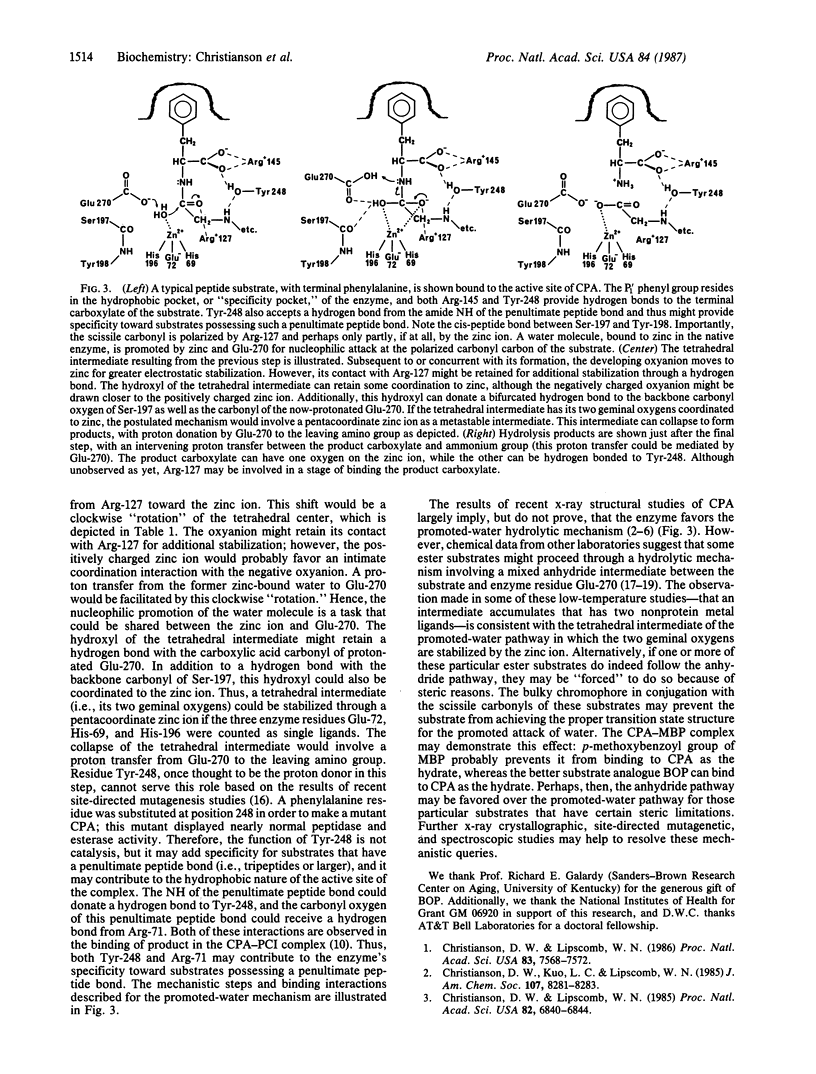Abstract
The structure of the complex between carboxypeptidase A alpha (EC 3.4.17.1) and the ketonic substrate analogue 5-benzamido-2-benzyl-4-oxopentanoic acid (BOP) has been determined by x-ray crystallographic methods to a resolution of 1.7 A (final R = 0.191). Interestingly, BOP was observed to bind to the active site of carboxypeptidase A alpha as the covalent hydrate adduct. Because BOP is probably less than 0.2% hydrated in aqueous solution, this result was unexpected. One possibility is that the zinc-bound water of the native enzyme added to the ketone carbonyl. Alternatively, the enzyme may preferentially scavenge the hydrated ketone as it is continuously maintained at equilibrium in the solution in which the carboxypeptidase A alpha crystals were immersed. In either case, this mode of binding of BOP to carboxypeptidase A alpha provides an example of the preferred binding of a model of a structure along the reaction coordinate of a hydrolytic reaction.
Full text
PDF



Selected References
These references are in PubMed. This may not be the complete list of references from this article.
- Christianson D. W., Lipscomb W. N. Binding of a possible transition state analogue to the active site of carboxypeptidase A. Proc Natl Acad Sci U S A. 1985 Oct;82(20):6840–6844. doi: 10.1073/pnas.82.20.6840. [DOI] [PMC free article] [PubMed] [Google Scholar]
- Christianson D. W., Lipscomb W. N. X-ray crystallographic investigation of substrate binding to carboxypeptidase A at subzero temperature. Proc Natl Acad Sci U S A. 1986 Oct;83(20):7568–7572. doi: 10.1073/pnas.83.20.7568. [DOI] [PMC free article] [PubMed] [Google Scholar]
- Galardy R. E., Kortylewicz Z. P. Inhibition of carboxypeptidase A by aldehyde and ketone substrate analogues. Biochemistry. 1984 Apr 24;23(9):2083–2087. doi: 10.1021/bi00304a032. [DOI] [PubMed] [Google Scholar]
- Gardell S. J., Craik C. S., Hilvert D., Urdea M. S., Rutter W. J. Site-directed mutagenesis shows that tyrosine 248 of carboxypeptidase A does not play a crucial role in catalysis. Nature. 1985 Oct 10;317(6037):551–555. doi: 10.1038/317551a0. [DOI] [PubMed] [Google Scholar]
- Grobelny D., Goli U. B., Galardy R. E. Inhibition of carboxypeptidase A by ketones and alcohols that are isosteric with peptide substrates. Biochemistry. 1985 Dec 17;24(26):7612–7617. doi: 10.1021/bi00347a017. [DOI] [PubMed] [Google Scholar]
- Kuo L. C., Makinen M. W. Hydrolysis of esters by carboxypeptidase A requires a penta-coordinate metal ion. J Biol Chem. 1982 Jan 10;257(1):24–27. [PubMed] [Google Scholar]
- Lewis C. A., Jr, Wolfenden R. Antiproteolytic aldehydes and ketones: substituent and secondary deuterium isotope effects on equilibrium addition of water and other nucleophiles. Biochemistry. 1977 Nov 1;16(22):4886–4890. doi: 10.1021/bi00641a022. [DOI] [PubMed] [Google Scholar]
- Makinen M. W., Kuo L. C., Dymowski J. J., Jaffer S. Catalytic role of the metal ion of carboxypeptidase A in ester hydrolysis. J Biol Chem. 1979 Jan 25;254(2):356–366. [PubMed] [Google Scholar]
- Pocker Y., Sarkanen S. Carbonic anhydrase: structure catalytic versatility, and inhibition. Adv Enzymol Relat Areas Mol Biol. 1978;47:149–274. doi: 10.1002/9780470122921.ch3. [DOI] [PubMed] [Google Scholar]
- Rees D. C., Lipscomb W. N. Refined crystal structure of the potato inhibitor complex of carboxypeptidase A at 2.5 A resolution. J Mol Biol. 1982 Sep 25;160(3):475–498. doi: 10.1016/0022-2836(82)90309-6. [DOI] [PubMed] [Google Scholar]


